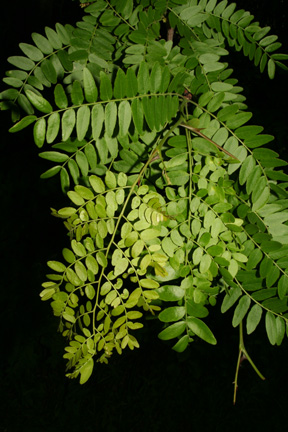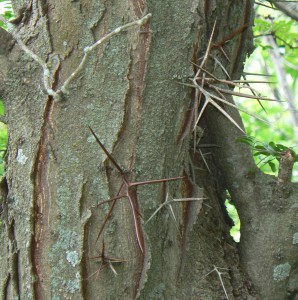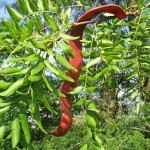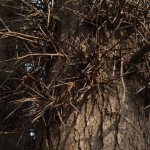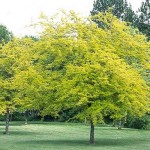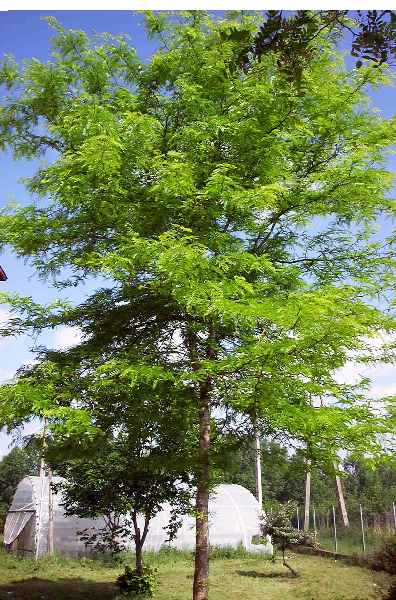 I took quite a particular interest in plant biology and the overall ecosystems of the forests of WI and the upper plains regions. In my later years in college I took courses in Botany and Dendrology, as well as a Human Issues Ecology course. One of my favorite things I learned about during my studies as a biologist is the origin, history, and physiology of my favorite tree, Gleditsia triacanthos.
I took quite a particular interest in plant biology and the overall ecosystems of the forests of WI and the upper plains regions. In my later years in college I took courses in Botany and Dendrology, as well as a Human Issues Ecology course. One of my favorite things I learned about during my studies as a biologist is the origin, history, and physiology of my favorite tree, Gleditsia triacanthos.
There are many reasons why I consider the Honey Locust to be my favorite of trees. The first such reason is fairly simple, I like the way that they look. Honey Locusts have compound leaves, which means that instead of single leaves and stems, they have a long stem with many (about 20 -30) leaflets. One thing that you will notice when looking at one of these trees is just how leafy they are. The large leaves give the tree a very distinct bushy look that I like in a tree. When you think of a tree you imagine a green leafy mass with a trunk, and that is what the Honey Locust looks like. The Honey Locust is a super-model in the world of dendrology. They are not without flaws, but are beautiful, popular, and deep down inside, they can be a bit prickly in person.
The Honey Locust is a very popular tree, and as you learn more about how they look, and how to identify them, you can begin to notice them pretty much everywhere. There are a few reasons for their popularity, probably the most of which is how hardy they are. This tree is often seen in urban areas, especially in the Midwest. Gleditsia triacanthos has the uncanny ability to withstand many of the pressures of the urban environment. They grow very fast, and make excellent shade-trees very quickly. The urban atmosphere and soil compaction affect this tree very minimally. Soil compaction is not a term you might be familiar with, what I am referring to is how compact and hard the soil can be around constructed areas. The Honey Locust doesn’t mind heat, or drought, and it is resistant to many diseases and bugs that affect trees. (Prepare for an upcoming article on the green menace, the asian invasion of the emerald ash borer). Part of why this tree is so popular might also have to do with the horrible dutch elm disease epidemic in the mid ’20s to the late 60’s in the U.S. Many of the cities in the U.S. had beautiful rows of Elm trees lining the streets before the fungus made it across the atlantic. Elms were very popular because they have a very nice arching shape that went well with the way that many towns and streets were laid out back then. You can just imagine riding down a street in the midwest in a big brown bomber car nearly completely shaded by big arching elms on either side of the road. The American Elm was a very abundant tree at the time, and like the Honey Locust, it too grew very fast and was tolerant of conditions in the city. Once these trees were all cut down due to the disease, many other new trees began popping up in the urban areas. The Honey Locust, and her cousin the Black Locust tree were some of the most popular. (Other small oaks and maples as well as the Ash tree were also adopted).
My favorite thing about the Honey Locust isn’t its looks, its popularity, or its hardiness, it is that it is kind of a living fossil in itself. Walking down the street past your local Honey Locust tree you wouldn’t notice it… but they are quite the sharp little fellow. Most of the trees you will see will not exhibit my favorite feature of this tree, the giant spikes. We are talking massive, sharp, and thick spikes. The trees used in landscaping are actually a breed of the tree that have had the spike-growing properties taken away. I suppose that is a good thing for the two year old little tommy tree-climber in your family, as well as any unwary or intoxicated individual walking down the street late at night. If you ever get a chance, you might be able to travel to some sort of arboretum (the UW Madison Arboretum has a great specimin) to check out the be-spiked variety of this tree.
Why would such a mild mannered and proper tree such as this need such a deadly looking defense mechanism? Herbivores. Who ever said a vegetarian never hurt anybody? Would be leaf-poachers such as deer and other small mammals find that when munching on leaves, the spines of this tree are a bit too much pain to make up for a tasty dinner. These herbivorous diners will have to go somewhere else if they want to keep themselves free of spiny, spiny pain. The Honey locust isn’t that mean though, because in the fall she will decorate the forest floor with delicious and nutritious seed pods. Gleditisia triacanthos is actually part of the legume family, and in the fall if you walk near a female tree you will find what look like gigantic brown pea pods. Tread lightly my friend, because you are standing upon the progeny of that very tree. If you want to be kind, you could pick up one of the pods and carry it somewhere a tree would be nice to find, and place it down, but don’t worry, the hungry deer and squirrels will do the rest of the spreading of seeds for you.
Back to the thorns. Many scientists hypothesize that these over-large spines, which only seem to stay on the trunks and larger branches, are actually a left-over defense mechanism from the ancient Pleistocene era after the dinosaurs. This was a time when giant mammals roamed the forests of the americas, and large elephantine creatures that oddly sounded not unlike Ray Romano battled a coming ice age. These large mammals such as the wooly mammoth or giant sloth would have been very keen on eating the branches of this tree if not for the many spikes. The humble little honey locust was able to stop the mighty mammoth with a little ingenuity, and a lot of spiky-ness. I think it is very cool to look at a tree and see a living remainder of those times. Very much like the Ginkgo tree and the alligator they are living fossils of a world can never see but only imagine, and I think that is really cool.
Here are a couple more glamor shots of this complicated, beautiful tree.
